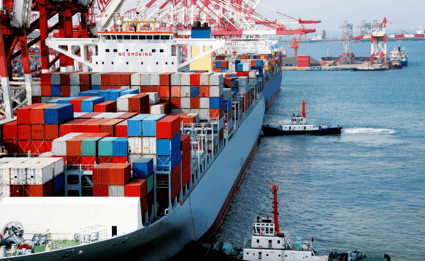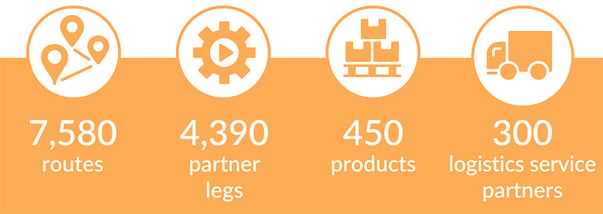Take Multimodal Shipping to a New Level with Network Optimization
Keith LaBotz - February 09, 2023

This case study is about an automotive OEM that took transportation management to the next level by optimizing its entire multimodal distribution network.
A leading global OEM manufacturer for multiple automotive brands that shipped finished vehicles to dealerships wanted to improve delivery reliability, cost savings, and greenhouse gas (GHG) emissions.
 The company’s operational scope and reliance on multi-modal transportation presented a complex ecosystem:
The company’s operational scope and reliance on multi-modal transportation presented a complex ecosystem:
- The transportation process managed more than one million shipments annually and over 300 carriers in 85 countries, representing 7,580 delivery routes consisting of 4,390 legs.
- Shipping requirements varied by automotive brand, destination, and transport carrier.
- Multimodal transportation made up a large chunk of the shipping volume, demanding precise planning and execution with multiple partners.
As you can imagine, capable TMS software was orchestrating this feat - the shipping operation was state-of-the-art in many respects. However, this shipper's vision for digitalization had them thinking differently.
They saw the bigger picture - a distribution network with many moving parts out of alignment. They also saw significant potential for gains in performance, cost reductions, and sustainability. And they realized it would require optimization beyond the confines of traditional transportation management.
The entire distribution network would have to be optimized, and if you’ve read the last several posts in this blog, you know where this is going. This company was ready for the next level of supply chain performance - aligning the enterprise around last-mile logistics.
Big Challenge Equals a Big Reward
While the potential gains were significant, so were the challenges of finding a capable technology partner.
Transportation optimization is generally limited to enterprise shipping operations. This siloed view of logistics is predominant in most software solutions and transportation strategies. Traditional TMS applications optimize carrier selection and identify order consolidations to reduce freight expenses within a planning horizon of one to four days.
Expanding transportation optimization beyond the shipping operations to include the broader distribution network requires cooperation from two distinct realms:
- Enterprise production and fulfillment processes and;
- The pool of external transportation providers and possibly a company’s private transportation fleet.
Optimizing a distribution network synchronizes planning and execution between these two areas. A change in either may result in changes in the other, requiring an iterative optimization process.
The company would need an optimized forecast and plan that its business enterprise and external transportation providers could execute.
Shipper Requirements for Multimodal Optimization
The requested solution would provide a single global platform for optimizing the company’s distribution network of assembly plants, dealer locations, and transportation providers.
- A supply chain data model and planning process for global visibility, monitoring, and optimization of all shipments in the supply chain.
- Unify disparate supply chain processes and several hundred external transportation providers.
- An optimized plan for the distribution network extending over a two-year horizon, beginning with current operational detail to at least two years into the future.
- Iterative optimization between enterprise production and fulfillment and external transportation schedules.
- Optimization factors affecting the schedules mentioned above include changes in demand, productivity, resources, port of entry and exit harbor dwell times, intermodal transfers, and transportation capacity.
- Optimization must evaluate operational logistics details for each leg in every route for all carriers, modalities, and shipments in multiple scenarios.
- Results provide long-range forecasting (6 + months), mid-range tactical planning (3-6 months), and daily operational plans (from minutes in advance out to 12 weeks of execution).
- Plans continuously adjust forecasts and operational objectives with changes across the network.
flexis Solution for MultiModal Optimization
The company partnered with flexis to implement a cloud solution for optimizing supply chain networks. A holistic data model incorporates all transportation and logistics details necessary to optimize long-range planning and operational planning.
flexis’ solution met all of the shipper’s requirements with this functionality:
- An integrated planning horizon that continuously updates with changing conditions across the network to ensure alignment at all levels, including daily logistics execution.
- The integrated plan consists of a “strategic plan” (6 months – two years), a “tactical plan” (3-6 months), and an “operational plan” (up to eight weeks horizon).
- Strategic Planning addresses Optimization through process improvements.
- Tactical Planning involves continuous network improvement, weekly demand scheduling, and capacity monitoring.
- Operational Planning involves detailed daily or weekly logistics planning and rescheduling.
- Monitoring carrier capacity, carrier ability to meet pickup and delivery windows, and equipment requirements.
- Transportation savings from consolidating shipments and orders, shipping from alternate factories, changing shipping dates, and alternate modalities.
Conclusion
While this case featured the flexis cloud optimizing a complex multimodal shipping scenario in the automotive manufacturing sector, it can do the same for operations of all sizes and industries.
If you want to learn more get your Guide to Logistics 4.0
In this Guide you will learn:
-
Why a strategic process in transportation planning is a top priority for digitalization
-
What megatrends will increase supply chain volatility
-
How to manage it
Want to learn more about Multimodal Transportation?
Download our presentation and learn:
-
How can transports be planned quickly and yet flexible so that CO2 savings are verifiable?
-
How do you make optimal use of a multimodal transport network that maintains supply in both the short and long term?
-
How can you more easily realize a modal shift when disruptions occur? And how do you keep a grip on your CO2 emissions in doing so?
flexis and BigMile present a Use Case of a modal shift and show that network optimizations and sustainability often go hand in hand.
LATEST POSTS
- Understand Circular Economy in The Manufacturing Industry
- How Can Industry 4.0 IT Integration Be Achieved Smoothly?
- The Significance of Order Sequencing in Discrete Manufacturing
- How to improve your Supply Chain Management: The Power of Control Towers
- Optimizing Human Resource Scheduling in Manufacturing: A Technological Approach




